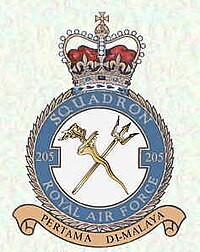No. 205 Squadron RAF
| No. 205 Squadron RAF | |
|---|---|
 | |
| Active | Royal Naval Air Service 2 August 1915 – October 1915 31 December 1916 – 1 April 1918 Royal Air Force 1 April 1918 – 22 January 1920 15 April 1920 – 1 April 1923 8 January 1929 – 31 March 1942 23 July 1942 – 31 October 1971 |
| Country | |
| Branch | |
| Type | Flying squadron |
| Role | Maritime Reconnaissance |
| Motto(s) | Malay: Pertama di Malaya ("First in Malaya")[1][2][3] |
| Commanders | |
| Notable commanders | H M Cave-Browne-Cave |
| Insignia | |
| Squadron Badge heraldry | A kris and a trident in saltire[3] The badge points to two aspects of the squadron's history, the trident referring to its RNAS origins and the kris to its association with Malaya[1][2] |
| Squadron Codes | KM (Apr 1939 – Sep 1939 Allocated, no confirmation of use)[4] FV (Sep 1939 – Mar 1942)[5][6] |
No. 205 Squadron was a
History
Formation and World War I
No. 5 Squadron of the Royal Naval Air Service was formed at Dover on 2 August 1915 from elements of No. 4 Squadron RNAS, which had relocated to Eastchurch. However, in October 1915, No. 5 Squadron ceased to exist as it was absorbed into RNAS Dover.
On 31 December 1916, 'B' Squadron of No. 5 (Naval) Wing was redesignated No. 5 (Naval) Squadron. It operated Sopwith 1½ Strutters, making bombing raids on Belgian ports and German airfields. In August 1917, the squadron was equipped with DH.4s. No. 5 (Naval) Squadron was attached to 5th Brigade of the Royal Flying Corps in February 1918. On 1 April 1918, at Bois de Roche, France (some sources say Petite-Synthe[1][7]), it transferred to the Royal Air Force and was redesignated No. 205 Squadron RAF. No. 205 Squadron's operations continued with raids against ports and attacks on German airfields until the end of the war. In September 1918, it was re-equipped with DH.9As.
It produced at least three notable aces, in
Between the wars
Reformed at RAF Leuchars on 15 April 1920, the squadron operated as a fighter-reconnaissance unit with Parnall Panthers. It was disbanded on 1 April 1923, after being redesignated to No. 441 Flight. The squadron was reformed when the RAF's
World War II
At the outbreak of
Cold War

No. 205 Squadron continued Catalina operations from its base at Koggala until 1949, when it was re-equipped with
Aircraft operated
| From | To | Aircraft | Variant |
|---|---|---|---|
| Dec 1916 | Jul 1917 | Sopwith 1½ Strutter | |
| Apr 1917 | Sep 1918 | Airco DH.4 | |
| Aug 1918 | Mar 1919 | Airco DH.9A | |
| Apr 1920 | Apr 1923 | Parnall Panther | |
| Jan 1929 | Feb 1936 | Supermarine Southampton | Mks.II |
| Apr 1935 | Oct 1941 | Short Singapore | Mk.III |
| Apr 1941 | Mar 1942 | Consolidated Catalina
|
MK.I |
| Jul 1942 | Mar 1945 | Consolidated Catalina I | Mk.Ib |
| May 1944 | Sep 1945 | Consolidated Catalina | Mk.IVb |
| Jun 1945 | May 1959 | Short Sunderland | GR.5 |
| May 1958 | Nov 1962 | Avro Shackleton | MR.1A |
| Apr 1962 | Oct 1971 | Avro Shackleton | MR.2C |
See also
- List of Royal Air Force aircraft squadrons
- Cathay Pacific VR-HEU
References
Notes
Bibliography
- Bowyer, Michael J.F. and John D.R. Rawlings. Squadron Codes, 1937–56. Cambridge, UK: Patrick Stephens Ltd., 1979. ISBN 0-85059-364-6.
- Flintham, Vic and Andrew Thomas. Combat Codes: A full explanation and listing of British, Commonwealth and Allied air force unit codes since 1938. Shrewsbury, Shropshire, UK: Airlife Publishing Ltd., 2003. ISBN 1-84037-281-8.
- Halley, James J. The Squadrons of the Royal Air Force & Commonwealth 1918–1988. Tonbridge, Kent, UK: Air Britain (Historians) Ltd., 1988. ISBN 0-85130-164-9.
- Jefford, C.G. RAF Squadrons, a Comprehensive record of the Movement and Equipment of all RAF Squadrons and their Antecedents since 1912. Shrewsbury, Shropshire, UK: Airlife Publishing, 1988 (second edition 2001). ISBN 1-85310-053-6.
- Moyes, Philip J.R. Bomber Squadrons of the RAF and their Aircraft. London: Macdonald and Jane's (Publishers) Ltd., 2nd edition 1976. ISBN 0-354-01027-1.
- Rawlings, John D.R. Coastal, Support and Special Squadrons of the RAF and their Aircraft. London: Jane's Publishing Company Ltd., 1982. ISBN 0-7106-0187-5.
- Shores, Christopher F., et al. Above the Trenches: A Complete Record of the Fighter Aces and Units of the British Empire Air Forces 1915–1920. Grub Street, 1990. ISBN 978-0-948817-19-9.
- Smith, Colin. Singapore Burning. Penguin Books, 2005. ISBN 0-14-101036-3.
